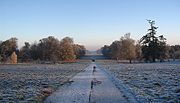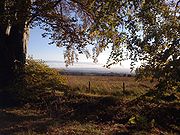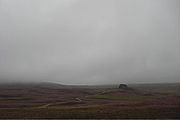
Marchmont Estate
Encyclopedia

Greenlaw
Greenlaw is a small town situated in the foothills of the Lammermuir Hills on Blackadder Water at the junction of the A697 and the A6105 in the Scottish Borders area of Scotland. Greenlaw was first made the county town of Berwickshire in 1596, and was the first town to take on this role since the...
in Berwickshire
Berwickshire
Berwickshire or the County of Berwick is a registration county, a committee area of the Scottish Borders Council, and a lieutenancy area of Scotland, on the border with England. The town after which it is named—Berwick-upon-Tweed—was lost by Scotland to England in 1482...
in the Scottish Borders
Scottish Borders
The Scottish Borders is one of 32 local government council areas of Scotland. It is bordered by Dumfries and Galloway in the west, South Lanarkshire and West Lothian in the north west, City of Edinburgh, East Lothian, Midlothian to the north; and the non-metropolitan counties of Northumberland...
area of Scotland
Scotland
Scotland is a country that is part of the United Kingdom. Occupying the northern third of the island of Great Britain, it shares a border with England to the south and is bounded by the North Sea to the east, the Atlantic Ocean to the north and west, and the North Channel and Irish Sea to the...
, circa 45 miles (72.4 km) south east of Edinburgh
Edinburgh
Edinburgh is the capital city of Scotland, the second largest city in Scotland, and the eighth most populous in the United Kingdom. The City of Edinburgh Council governs one of Scotland's 32 local government council areas. The council area includes urban Edinburgh and a rural area...
. It is situated in the Merse
Merse
Merse may refer to:*The Merse , in the Italian region of Tuscany*The Val di Merse, an area including the valley of the river Merse* the Merse , a territory located on the on the boundaries of Scotland and England on the east side; today part of Berwickshire* A Scottish name for Salt marsh, an...
, an area between the Lammermuirs to the north and the Cheviots to the south. It is part of what is commonly regarded as an exceptionally beautiful landscape, comprising a diverse range of land types from high and exposed grouse moor to rich alluvial agricultural land. The life of the estate has seen many stages, including rapid growth, shrinkage and stability, from its foundation in the fifteenth century under the first Hume owner, Patrick Hume, of Polwarth, through his successors and subsequent owners to the present day.
History
The history of Marchmont Estate can only be marked out by noting the changes to its constitution during the course of its existence. There are a number of documents on the matter in places such as the National Archives of ScotlandNational Archives of Scotland
Based in Edinburgh, the National Archives of Scotland are the national archives of Scotland. The NAS claims to have one of the most varied collection of archives in Europe...
and Register House in Edinburgh, but many of these are estate papers dealing with internal or personal issues rather than the bigger picture. This article is interested more in the fluctuations of its size and reasons for this these changes.

Polwarth
Polwarth may refer to:*Polwarth , a breed of sheep*Polwarth, Edinburgh*Polwarth, Scottish Borders*Patrick Hume of Polwarth, makar in the court of James VI of Scotland*Electoral district of Polwarth in the Parliament of Victoria, Australia...
(which was the core of the estate of Marchmont), a small but prosperous parish between Greenlaw and Duns
Duns
Duns is the county town of the historic county of Berwickshire, within the Scottish Borders.-Early history:Duns law, the original site of the town of Duns, has the remains of an Iron Age hillfort at its summit...
. The name of the family seat was Redbraes Castle tp which they removed from Polwarth Castle following the latters destruction in the 'Rough Wooing'wars of the 1540s. The Humes of Polwarth acquired the barony through marriage in 1470. A staunch supporter of William of Orange
William III of England
William III & II was a sovereign Prince of Orange of the House of Orange-Nassau by birth. From 1672 he governed as Stadtholder William III of Orange over Holland, Zeeland, Utrecht, Guelders, and Overijssel of the Dutch Republic. From 1689 he reigned as William III over England and Ireland...
, Sir Patrick was forced to flee to Holland and Polwarth estates were confiscated in 1686. He returned with the new king, King William III of Great Britain in 1689 and was rewarded greatly by the king for his brave loyalty by being given the title Lord Polwarth in 1690. In addition his lands and other dignities were restored to him. Moreover, he was made Lord Chancellor in 1697 and created Earl of Marchmont, and then in 1698 was elevated to "the highest official position in the kingdom, that of the King's High Commissioner to the Parliament". These positions came with immense political power and therefore wealth. It is with this wealth that Marchmont Estate was able to grow so quickly while the Earl bought up surrounding lands and houses.
Changing fortunes
The late 17th Century and most of the 18th Century saw the rapid expansion of the estate while the Humes of Marchmont were at their strongest financially and the most powerful magnates in Berwickshire. It was not however until 1755 that the Hume family moved from Redbraes Castle adjacent to their new home, Marchmont HouseMarchmont House
Marchmont House lies on the east side of the small town of Greenlaw, and near the former village of Polwarth in Berwickshire, in the Scottish Borders area of Scotland. It is about five miles south west of Duns, about west of Berwick-upon-Tweed and about south east of Edinburgh...
, a family seat befitting such an estate. Ideas and plans had been drawn up earlier in the century by Alexander the 2nd Earl
Alexander Hume-Campbell, 2nd Earl of Marchmont
Alexander Hume-Campbell, 2nd Earl of Marchmont PC , was a Scottish nobleman, politician and judge.Third but eldest surviving son of Patrick Hume, 1st Earl of Marchmont, by his spouse Grisel , daughter of Sir Thomas Ker of Cavers, he assumed the additional surname of Campbell upon his marriage in...
, but it was not until Hugh, the 3rd Earl
Hugh Hume-Campbell, 3rd Earl of Marchmont
Hugh Hume-Campbell, 3rd Earl of Marchmont PC FRS , styled Lord Polwarth between 1724 and 1740, was a Scottish politician....
’s time that the house was actually built. The construction of this great house, together with many of the land purchases in the 18th Century, were funded to a large extent by the sale of Cessnock estates, which came into the ownership of the family following the marriage between the Alexander the 2nd Earl, and Margaret Campbell. She was “a great heiress, and on her father’s death, in 1704, her husband succeeded him, not only in his Ayrshire estates, but also in his place on the Scottish Bench, where he sat under the same title of Lord Cessnock”. The political power and wealth of the Hume family therefore continued. “Lord Marchmont took a great interest in his estates,....he laid out a great deal of money on his property and very much increased its extent by the purchase of Home Castle and its surrounding lands, and also of other farms lying nearer the Tweed”.


The 1825 survey states that the lands extend to about 21000 acres (85 km²). Such was the importance of the estate that a railway station was built for it, presumably as much for agricultural use as personal. The station was situated between Duns and Greenlaw stations on the Berwickshire Railway line which was opened on August 1, 1849 to join Reston to the main Edinburgh to Hawick line at Ravenswood Junction near St Boswells. The track at Marchmont was lifted in 1953. However by the time the estate was put up for sale in 1913, approximately 90 years later, the estate had reduced in size to about 13500 acres (54.6 km²). in fact the size of the estate when eventually sold at auction was 5000 acres (20.2 km²). The reduction in the size of the estate was due to the dwindling wealth of the Hume family of Marchmont. Many of the outlying farms were sold off, in particular the belt of estate situated south of Greenlaw such as Hume, Stanmore, Belmont and Hassendean. These are recorded as being part of Marchmont in a plan of the estate dated 1902. Therefore the disposal of these must have taken place in the first few years of the 20th Century. The central core north and north west of Greenlaw was largely retained. It is no surprise that the parkland around the house has changed little over the 250 years or so since the house was built. Although some trees have been cut down, the handsome avenue, arguably the longest in Scotland, stills leads to the house from a north easterly direction. During the remainder of most of the 20th Century and during the time of the former proprieter the estate comprised the following farms: Woodheads, Whiteside Slegden, Clerkenville, Castlemill, Elwartlaw and Cothill, the last two being sold off in about 1978 and 1981 respectively. However latterly the estate has seen some of areas of land bought back or added. It now has about 5500 acres (22.3 km²) of freehold land and a further 3500 acres (14.2 km²) of leased land, a total which is significant by modern day standards.
Research into the subject shows there are a number of documents of incidental interest that one comes across that tell a more human story about the estate and its workings. The Marchmont estate “Work Bork” of 1743-45 lists, day by day, the tasks of the estate labourers, where they worked and how much they were paid. We can take Jo Nisbet, one of those workers, as an example. He is detailed as “digging Marle” on Monday 20th. Marl, like lime was used as a soil additive, improving it chemically and biologically, and was used in areas such as this in Berwickshire and Roxburghshire which had clay soil. At places like Marchmont in the lowlands, adding marl and lime was central to agricultural success by improving the soil.. He then went on to carry out other duties such as “moeing” or “forking hay”, “holding up plow”, “threshing oats”, and “draining nursery”. For 4 days work they would be typically be paid ¼, going up to 2- for 6 days work. Most of the 25 or so men worked 6 days a week, even on Christmas Day and other days we would consider holidays.

